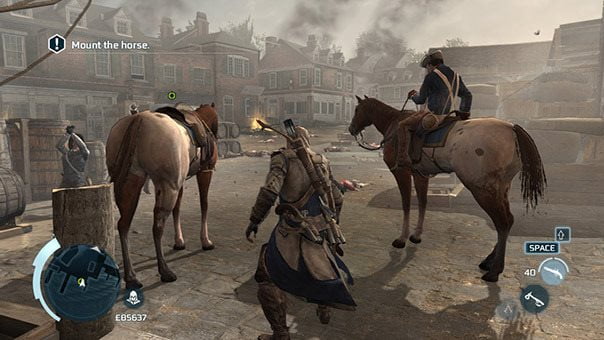
Assassin’s Creed III was the game that essentially kickstarted me blogging, as I talked about the design of its different levels. That series of posts was pretty popular among the Assassin’s Creed community, though to be honest I tried to reread it and I think it’s just better if I don’t open up my writings from several years ago, because it makes me want to faceplant myself into the table (even if from outside perspective there’s no real reason to). On the plus side, that impulse at least shows that I’ve gained experience over the years.
Now I come back to Assassin’s Creed III in this ongoing blog post series I write based on the whole franchise, and the topic of mission design as well (though not any single mission in particular). I think the game is very suited for studying the principles of open-world level design, and not because it excels at it. When you take the game as a whole – it doesn’t. But it does have plenty of both positive and negative examples of open-world missions, which means their analysis provides very useful learnings that I’m going to share with you right now.
0 – It’s OK to break the rules as long as it makes sense to do so
Before I start, I would like to mention that each learning that I defined is more of a guideline. It’s fine to not follow it, as long as it makes sense for the player. So for each principle I’ll try to find an example when it’s ok to ignore it.
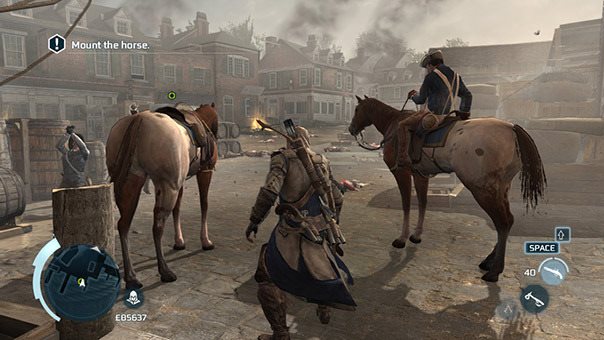
1 – Allow the player to reach a destination the way they want
In an open-world game, if you want the player to go from point A to point B, all you have to do is just put a marker on point B and tell to reach it (well, that, and make the world itself have plenty of navigation possibilities). This may seem like something obvious, especially considering that previous Assassin’s Creed games do this a lot, but in Assassin’s Creed III this doesn’t happen all the time.
Let’s take for example the Battle of Bunker Hill mission, where your first objective is to reach Putnam. Not only you have to be close to a random continental soldier who will lead you to the objective, he also won’t move unless you’re on a horse. If you don’t follow those conditions and try to get to Putnam by yourself, then it’s mission failure and restart from checkpoint. This is incredibly restricting. If you want the player go through a certain linear path, then provide a classical linear environment. Like the Tomb levels from previous games do, or in case of Assassin’s Creed III, the Treasure Map levels. Fort Wolcott, for example, is a linear level, and it’s very enjoyable. But open-world environment and strict linear pathways kinda don’t mix.
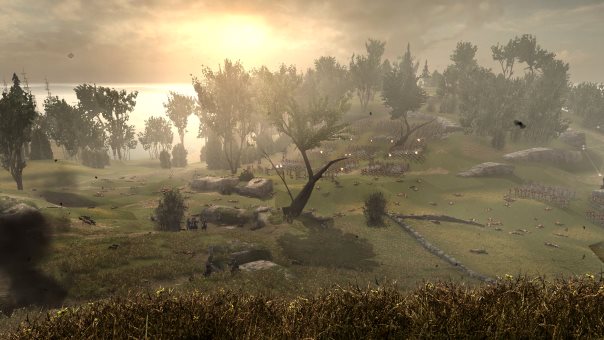
That said, same Battle of Bunker Hill mission also has an example of where it makes sense to not let the player go the way they want. I’m speaking about the massive British forces and their firing lines that stand between you and your assassination target. They kill you if you get too close. Now in my post from years ago dedicated to this same mission I’ve mentioned the opposite, that the player SHOULD be able to approach them and go through them. But, really, it was mostly the desire to see the event from E3 CGI trailer happening in the game proper.
Technically I don’t think it would be possible as there’s just too many damn NPCs to worry about. In Assassin’s Creed: Unity with the next-gen technology – yeah, but Assassin’s Creed III uses tricks and mirrors to show massive amounts of people. And, purely from the player perspective, it makes sense that a lone person charging straight into an army would die. Even if it’s our awesome Assassin.
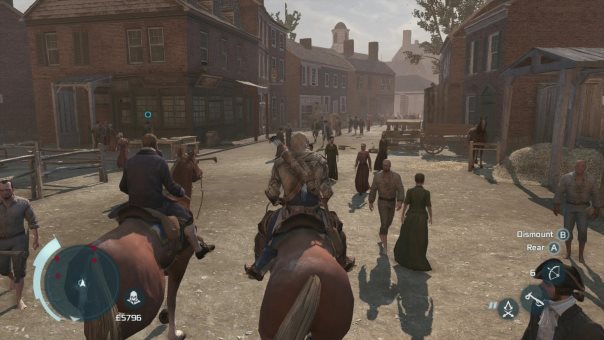
2 – Have NPCs adapt to the player, not the other way around
In Assassin’s Creed it happens from time to time that you have to walk to a certain location with a friendly NPC while a conversation is going. Or just to follow an NPC somewhere. And you either follow the pathway of the NPC, or you risk failing the mission. In general, you’d want there just to be a marker like in previous point, and have NPCs that accompany the player adapt to his behavior.
The exception can be the moments when player HAS to see some particular location, like for example a tutorial tour around the home base. Also, of course, if it’s an antagonistic NPC, like a tailing target, then yes, it’s the player who should adapt to the NPC as that’s part of the goal.
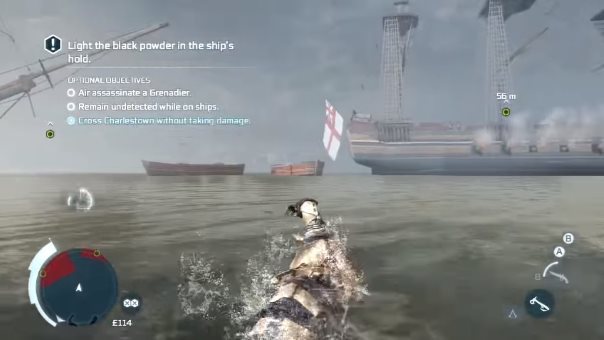
3 – Optional Objectives should fit with the character and preferably not define playstyle
Ah, optional objectives. Assassin’s Creed III has the whole range of all the different kinds of them.
There are the arbitrary ones that make absolutely no sense. Like in the Conflict Looms mission, there’s an optional objective to air assassinate a grenadier on one of the ships. The tricky part is that you also have an optional objective to not get detected by anybody. So to complete this objective, you need to clear the ship first before setting up an air assassination. But the main objective requires you to light the powder and destroy the ships anyway, so both the detection and air assassination constraints just feel arbitrary.
Then there are ones that conflict with the character. In the mission The Angry Chef we must assassinate in low profile five guards (non-lethal knockouts don’t count). All while Connor tries to tell the angry chef from the mission name that violence is not the answer. Those are two contradicting things. This is made more complicated by the fact that in Assassin’s Creed, optional objectives are justified as achieving ‘full synchronization’, i.e. doing missions the way the ancestor has done them. And Connor comes up as quite a hypocrite when in cutscenes he’s against unnecessary violence, but optional objectives in a number of missions have unnecessary violence. And the Animus justification of ‘this is not necessarily how it happened’ doesn’t work in this case.
There’s also objectives that force the player to go through the mission a certain way. For example, in Battle of Bunker Hill, there’s an optional objective to air assassinate our target. The problem is, this instantly makes the player go through the area a particular way without trying to improvise and find their own path, in a game where freedom of choice and approach are supposed to be important.
There are good optional objectives though as well, like in Battle of Monmouth mission during the retreat section there’s a side objective to prevent patriot executions. This fits the character – Connor wouldn’t let his allies be executed in battle. This adds to the challenge – there’s a time limit for the whole retreat and the player needs to make sure he completes both the main and side objective in time. And it doesn’t define the playstyle, the objective doesn’t say ‘kill executioners with your bow’ or something like that. In fact, the player doesn’t even have to kill the executioners, just distract them so the patriots would escape.
In terms of exceptions, there’s a good example in the mission Broken Trust, where the optional objective is to stop people from your tribe with non-lethal methods. Yes, completing this objective defines a playstyle for the player, but it also is in line with Connor’s character – he wouldn’t kill his kinsmen.
In general, though, I think a good approach to making optional objectives is to design a side goal rather than a method of completing a main goal.
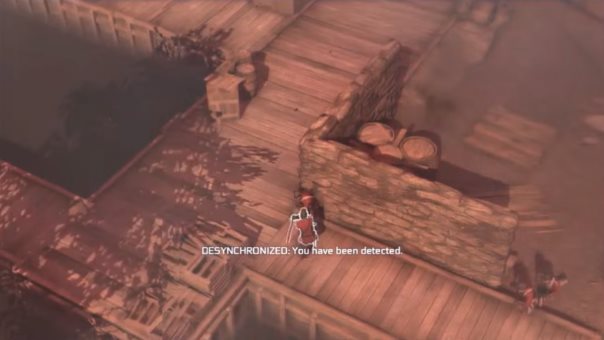
4 – Mission Failures should serve as a last resort
Ideally, as much as possible you’d want player’s death to be the only way to fail a certain mission. Getting far from an ally, getting detected, all this shouldn’t lead to a game over state, but to a change of context. If you’re detected then you engage in combat and situation changes (let’s say your objective becomes more heavily guarded), if you’re far from an ally then if he doesn’t follow you then he at least waits for you.
A good example in Assassin’s Creed III is the mission Hostile Negotiations. It’s an assassination level where you have to kill William Johnson. You don’t fail the mission if you get detected on approach (although you do fail the optional objective to get to Johnson undetected). You don’t fail the mission if Johnson sees you, in that situation he will start running away and you have to chase him. Similarly, you don’t fail the mission if all the natives are killed in the fight that might occur (although you will fail an optional objective).
Forced failure should be a situation where change of context is not possible. If an ally is dead, for example. Or, if we talk about detection, if getting detected is not something that is narratively feasible. Perhaps it’s not ideal, but understandable from player perspective why it happens.

5 – Make sure the missions are designed to utilize as many tools as possible
Assassin’s Creed III provides quite a lot of tools for the player, both in terms of items that you have, as well as in terms of Assassin Recruit abilities. The problem is, most of the time missions don’t account for those tools to be utilized.
For example, there’s an Assassin Recruit ability which makes them dressed in guard uniform and you fake imprisonment. It’s a cool play on the Monk/Courtesan blending from previous games. The problem is, this ability, introduced in the second half of the game, is effectively used only in the side mission where you get it. After that, well… it can still be used for capturing Forts, but none of the main missions have any instance where it could be useful, so it just… sits there as an ability.
A mission which does have pretty cool tool usage capabilities is The Tea Party. In the first part of the level you have to clear the area from Redcoats. You can of course do this simply by engaging into group close combat, but you also can use smoke bombs and poison darts to make it all easier. Weirdly enough, the Riot assassin recruit ability that you get slightly earlier in the main storyline is deactivated here, but abilities from other Boston recruits are present, and the Marksman can be used to help you clear the area.
The second half of the level is based on defending the area on ships while your allies throw away tea, and you can utilize combat Assassin recruit capabilities like Bodyguard or calling to assassinate attacking redcoats. This is also I think the only mission in the game where I used Tripwire Bombs, as you can strategically place them on boarding planks so it’d take care of boarding redcoats while you’re fighting on another side of the area.
When it comes to exceptions for this principle, there’s no real way to define it I think. Because you can’t design every mission to utilize absolutely every tool under player’s disposal. But what you should do, I think, is try to make sure that any given tool has enough reasons created in levels to be utilized over the course of the game.
Now, of course, there are more learnings that can be taken from Assassin’s Creed III, but they’d also apply to level design in general I think. The ones I’ve listed is something that I feel is important for open-world missions in particular, though now that I think about it they also can apply to level design in games in general. With these principles listed, I want to do a quick rundown of which section of Assassin’s Creed III has positive open-world mission design and examples, and which section has negative.
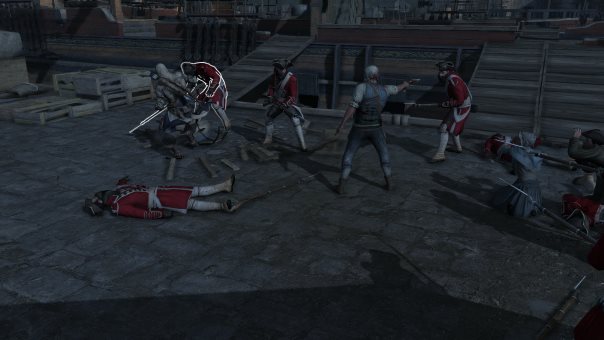
Positive Mission Design examples: Sequence 6
While Sequence 6 missions do have a few blunders, mainly in the optional objectives department, they’re a very good positive example of open-world mission design.
You have On Johnson’s Trail, which is a mission that allows you to explore Boston and complete side objectives as you go to an open restricted area with smuggled cargo that you need to destroy, and you travel around the area and complete the objective as you see fit.
Then you have The Angry Chef which is a nice follow and protect mission. As you were provided quite a bit of freedom in the previous level, the more linear approach does not ruin the experience.
After that goes The Tea Party, starting out as an open-ended clear out the area scenario, and then transitions into an intense combat/enemy management situation where you have to throw out tea crates while protecting your allies from oncoming British soldiers. This and the previous mission are less open-ended overall, but they still provide variety and choices in the context of their goals, which is important.
This whole sequence concludes with a classic Assassin’s Creed open-world assassination in Hostile Negotiations. You have your starting location and the location of your target, you get there whichever way you want, assassinate the target, and escape.
You play through this sequence, and you feel it – this is what Assassin’s Creed is about, a narrative-driven open-world experience. It’s thoroughly enjoyable and probably my favourite sequence of the whole game.
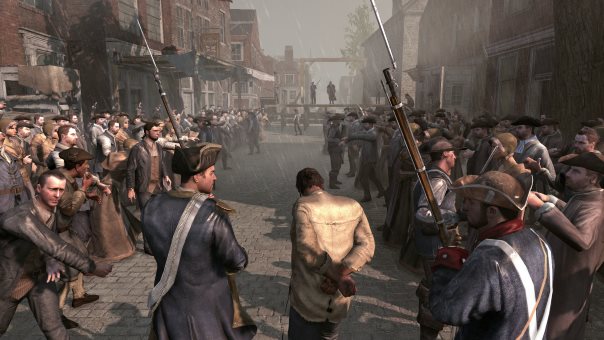
Negative Mission Design examples: Sequence 8
Then we have Sequence 8, which I would call my least favourite sequence of the whole game.
The first mission is Something on the Side, which marks your absolute first visit to New York, only you can’t explore the city at all. As soon as you enter it, you have to follow your ally throughout a predetermined path (or fail the mission). Straight after that, you have to tail a target on a predetermined path (or fail the mission). And then you have to chase another target through the city, or, well, fail the mission. And after you catch the target, you don’t get to explore the open-world, you get to prison.
Which is the focus of the Prison Bridewell mission. It’s long, it’s boring. You have to eavesdrop from inside your cell, then go to sleep, then go to talk to a guy, then play a board game with him, and it’s an errand after an errand in the same area. And you don’t even get to escape after all the trouble.
The next mission is Public Execution. Which is an assassination mission, but it consists of a linear pathway through the crowd that you have to go to first, and then after a cutscene, a quick charge and run to your target. And straight after you complete the mission, you get teleported to an absolutely different location entirely, out of New York.
This sequence introduces you to a whole new city but doesn’t let you explore an inch of it, it’s a linear pathway after linear pathway after linear pathway, you get robbed of all your tools and mostly have just one way to do certain thing or another, and in my opinion, an example of how not to handle missions in an open-world environment.

In conclusion, the overall main principle of open-world mission design that I’ve learned from Assassin’s Creed III, is to provide players the ability to express themselves within the context of the mission. Ideally that context is as open-ended as possible, but to add variety you can define its limits and other additional restrictions where it makes sense and in a way that doesn’t fully rob the players of their agency.
Thank you all for reading, hope you enjoyed it. Feel free to leave any comments below. If you’d like to keep an eye on my future blog posts, feel free to follow me on Twitter
@farlander1991
[Source:- Gamasutra]





